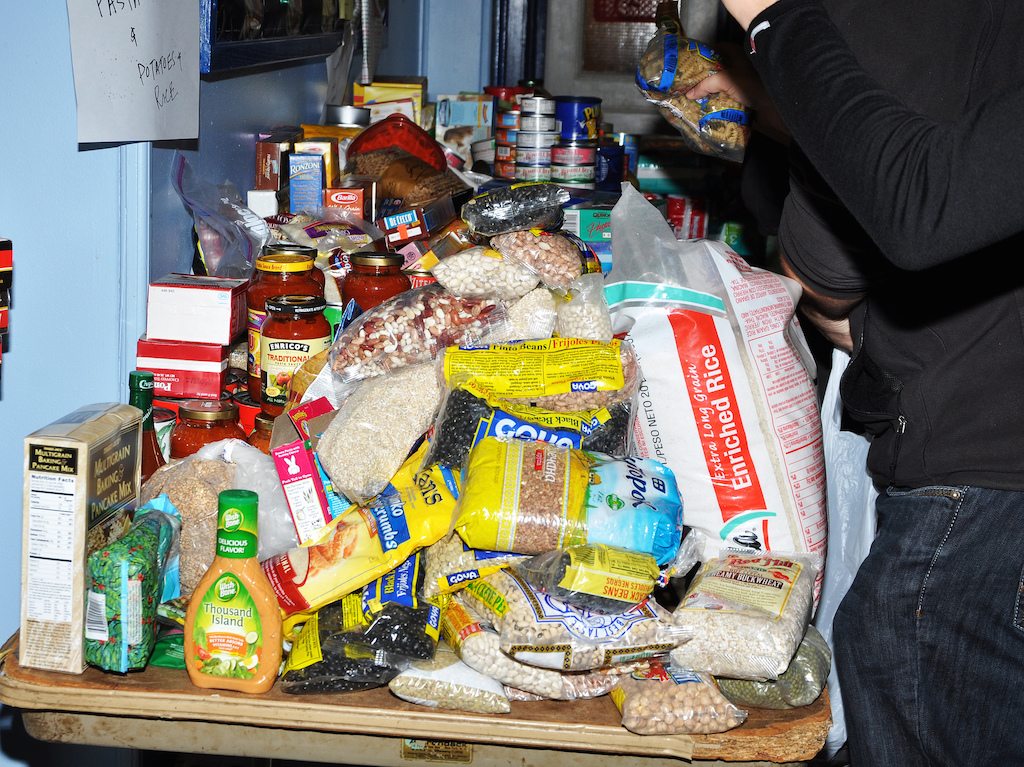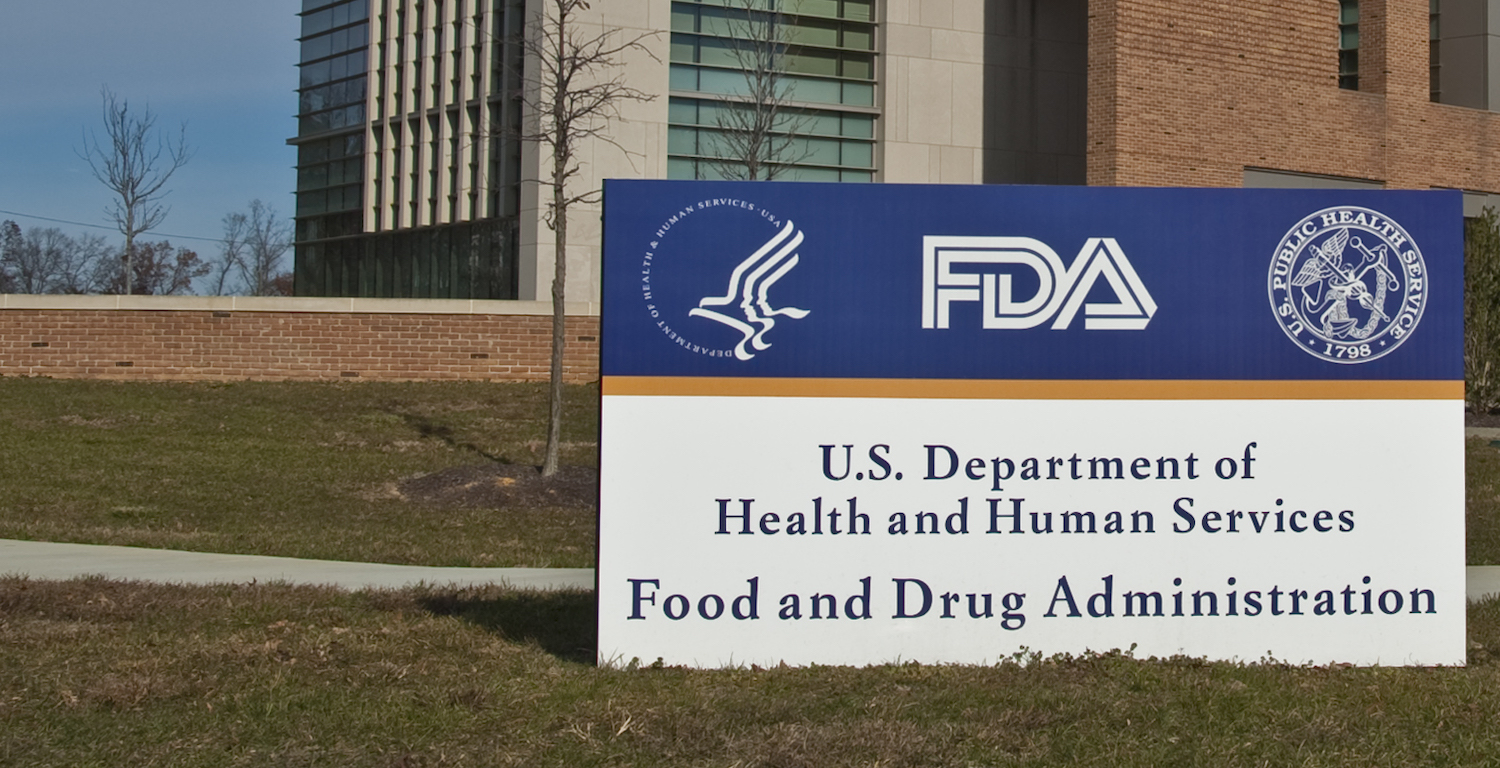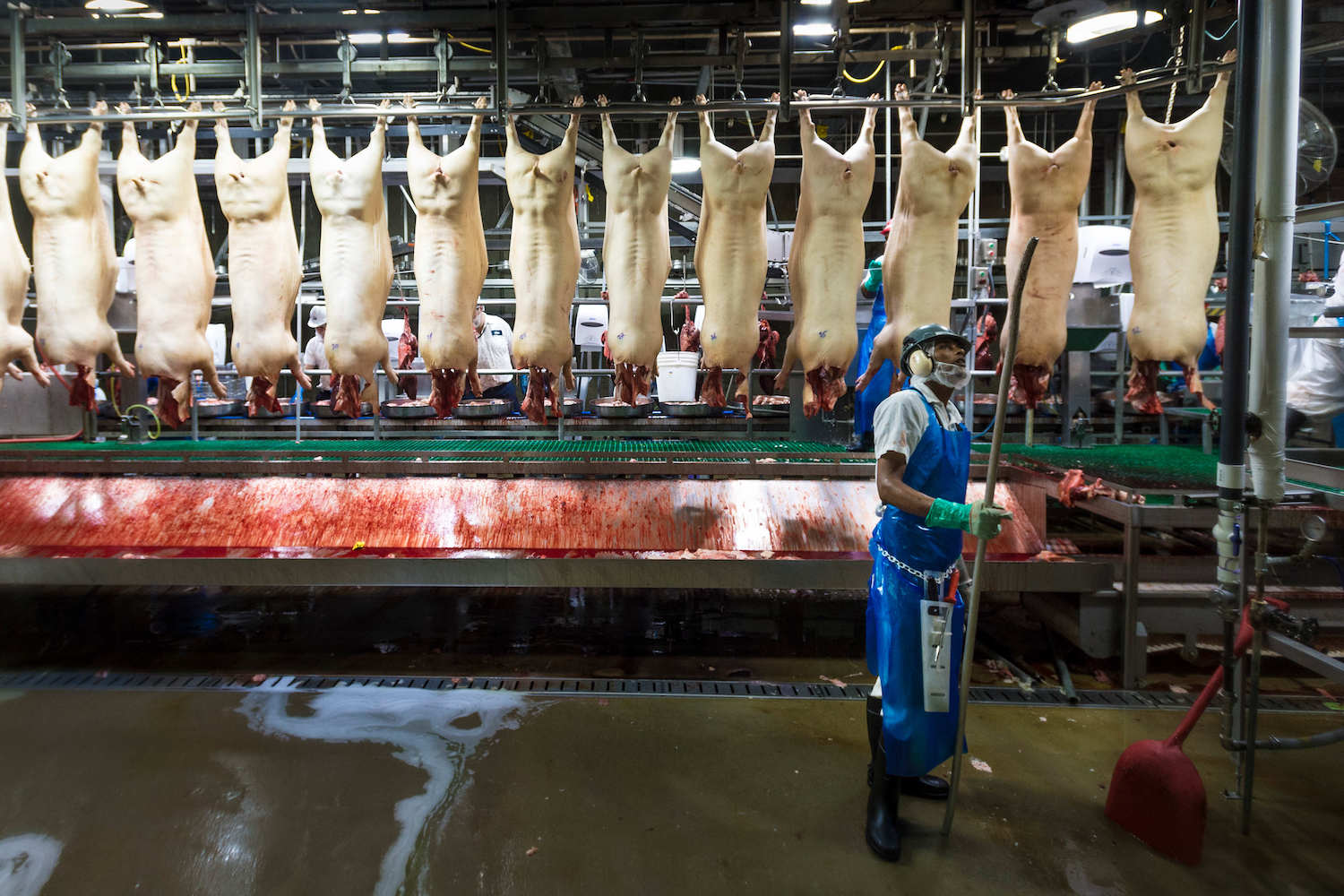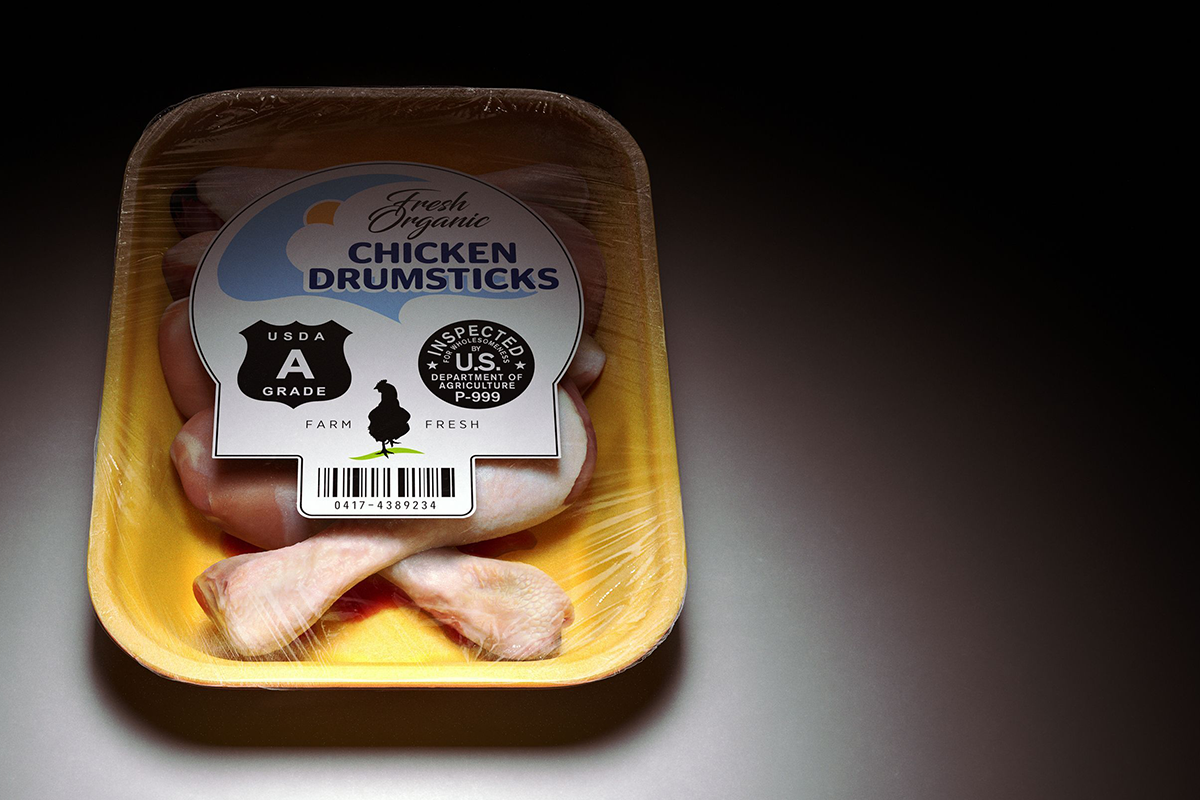
Photo Illustration by Justin Metz for ProPublica
For years, a dangerous salmonella strain has sickened thousands and continues to spread through the chicken industry. The USDA knows about it. So do the companies. And yet, contaminated meat continues to be sold to consumers.
In May 2018, a rare and virulent strain of salmonella caught the attention of America’s top disease detectives. In less than two months, the bacteria had sickened more than a dozen people, nearly all of them on the East Coast. Many said they’d eaten chicken, and federal food safety inspectors found the strain in chicken breasts, sausages and wings during routine sampling at poultry plants.
But what seemed like a straightforward outbreak soon took a mystifying turn. Cases surfaced as far away as Texas and Missouri. A 1-year-old boy from Illinois and a 105-year-old woman from West Virginia fell ill. There was a teenager who’d just returned from a service trip in the Dominican Republic and a woman who’d traveled to Nicaragua. But there were also people who hadn’t traveled at all.
Victims were landing in the hospital with roiling stomach pains, uncontrollable diarrhea and violent bouts of vomiting. The source of the infections seemed to be everywhere.
Even more alarming was that this strain of salmonella, known as multidrug-resistant infantis, was invincible against nearly all the drugs that doctors routinely use to fight severe food poisoning.
Even more alarming was that this strain of salmonella, known as multidrug-resistant infantis, was invincible against nearly all the drugs that doctors routinely use to fight severe food poisoning.
With a public health threat unfolding across the country, you might have expected federal regulators to act swiftly and decisively to warn the public, recall the contaminated poultry and compel changes at chicken plants. Or that federal investigators would pursue the root cause of the outbreak wherever the evidence led.
None of that happened.
Instead, the team at the Centers for Disease Control and Prevention closed the outbreak investigation nine months later even though people were continuing to get sick. The U.S. Department of Agriculture, which oversees meat and poultry, was not only powerless to act but said nothing to consumers about the growing threat. So supermarkets and restaurants continued selling chicken tainted with drug-resistant infantis.
And they continue to do so today.
An unchecked spread through the U.S. food supply was all but inevitable, the byproduct of a baffling and largely toothless food safety system that is ill-equipped to protect consumers or rebuff industry influence.
An eight-month ProPublica investigation into this once rare, but now pervasive form of salmonella found that its unchecked spread through the U.S. food supply was all but inevitable, the byproduct of a baffling and largely toothless food safety system that is ill-equipped to protect consumers or rebuff industry influence.
Several European countries have dramatically reduced salmonella in poultry by combating it on the farms where chickens are raised. But over the past 25 years, the U.S. has failed to bring down the incidence of salmonella food poisoning — even as the rates for E. coli and other bacteria have fallen dramatically.
Consumers may get the impression that the meat and poultry they find at supermarkets is safe because it bears the USDA seal of approval. But the agency doesn’t prohibit companies from selling chicken contaminated with dangerous salmonella like infantis. And even when people get sick, it has no power to order recalls.
Instead, the agency relies on standards it can’t enforce and that don’t target the types of salmonella most likely to make people sick. The USDA’s Food Safety and Inspection Service, unlike its counterparts in some countries, has no authority to control salmonella on farms, where the bacteria often spreads. And even when there’s persistent evidence of contamination in a plant’s products, the USDA can’t use those findings to suspend operations. All the agency can do is conduct a general review of the plant, and that rarely leads to a shutdown.
“It’s a system that’s untenable,” said Sarah Sorscher, a consumer advocate at the Center for Science in the Public Interest.
Over the past 25 years, the U.S. has failed to bring down the incidence of salmonella food poisoning — even as the rates for E. coli and other bacteria have fallen dramatically.
ProPublica, as part of its food safety investigation, has created an online database that lets consumers look up the salmonella records of the plants that processed their chicken and turkey.
Last week, after repeated interview requests from ProPublica and years of criticism from consumer groups, the USDA announced that it was rethinking its approach to salmonella. The agency didn’t announce any concrete changes but said it would set up pilot projects and hold meetings in an effort to come up with a plan.
“Whether it should have been done sooner or could have been done sooner, the good news is we’re doing it,” said Sandra Eskin, the agency’s deputy undersecretary for food safety. “We’re going to really take a look at everything we could look at and, I hope, develop a different approach that winds up being more effective.”
Scientific advancements over the last decade have provided the USDA with tools to identify the most dangerous strains of salmonella. But the agency isn’t using those tools to prevent it from spreading in our food supply.
Through dozens of public records requests, ProPublica was then able to link the genetic information on those 8,000 samples to the foods that victims ate and the processing plants the chicken samples came from.
To piece together how food safety officials and the poultry industry allowed infantis to spread, ProPublica used the same genetic data available to the USDA and other agencies, analyzing seven years of infantis samples taken from food and patients and catalogued by the National Institutes of Health.
Through dozens of public records requests, ProPublica was then able to link the genetic information on those 8,000 samples to the foods that victims ate and the processing plants the chicken samples came from.
The analysis, along with hundreds of internal government records and interviews with nearly two dozen scientists, allowed us to uncover that the infantis outbreak never abated and has continued to run rampant through the chicken industry.
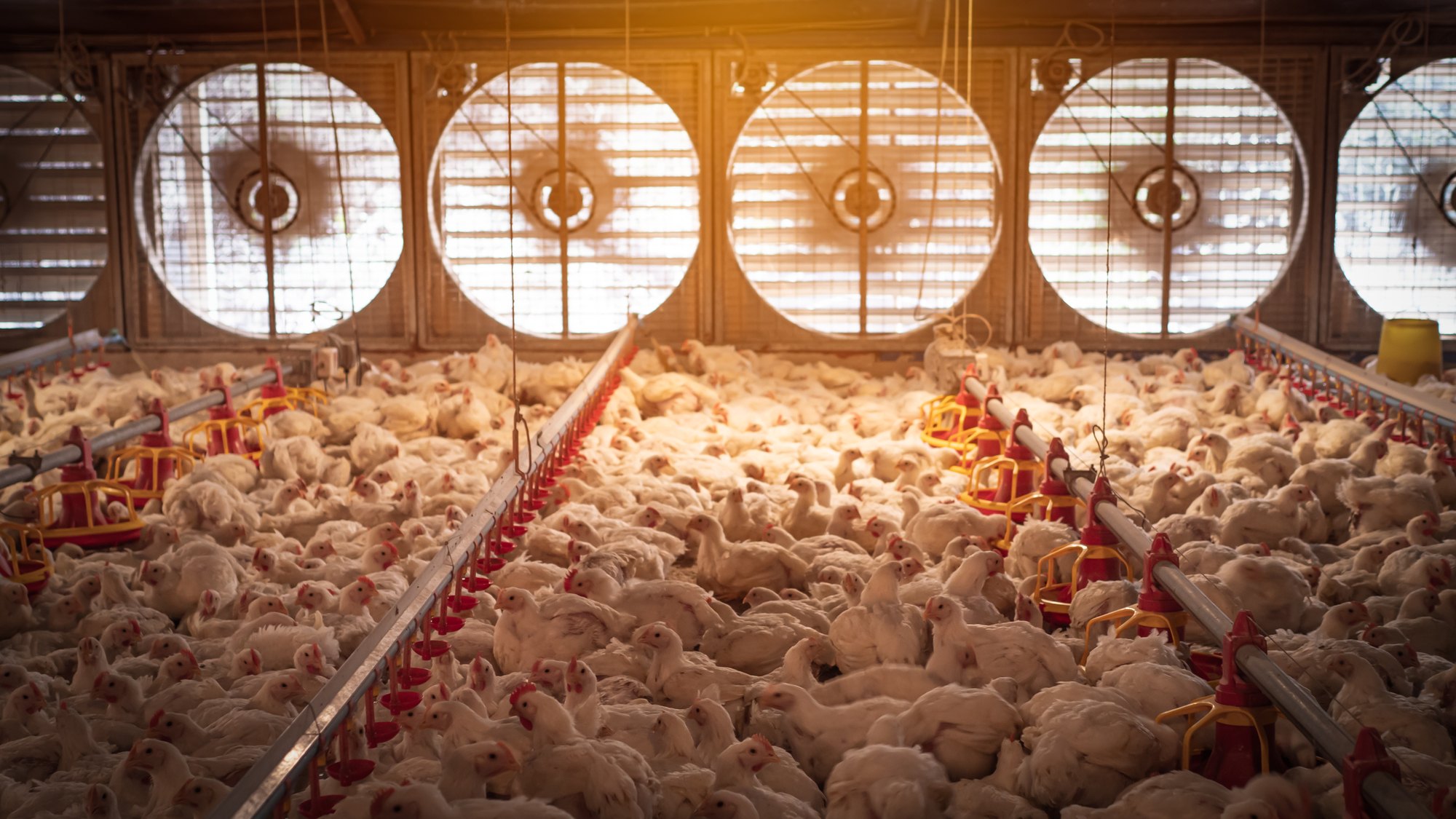
The Centers for Disease Control and Prevention (CDC) noted that an outbreak of salmonella infantis, a multidrug-resistant strain, was “widespread in the chicken industry” and believed to be expanding. Regardless, they closed their investigation in 2019 as no further actions could be taken to stop the spread.
In fact, ProPublica found that more than twice a day this year, on average, USDA inspectors detected multidrug-resistant infantis in poultry that’s genetically similar to the outbreak strain. Each month, the CDC continues to receive dozens of reports of people getting sick from it.
“Many people are still becoming ill, and some of them gravely ill,” Robert Tauxe, director of the CDC’s Division of Foodborne, Waterborne and Environmental Diseases, told ProPublica.
One internal CDC presentation noted that this single strain is “responsible for an estimated 11,000-17,000 illnesses per year.” But the CDC is limited in its ability to protect American consumers from foodborne illnesses. It has no power to order companies to take action or to provide information that would help it solve outbreaks.
And the CDC, despite noting that the strain was “widespread in the chicken industry,” took the spotlight off infantis when it closed its outbreak investigation in February 2019. Tauxe said the investigation ended because the agency had learned as much as it could. “That does not mean that the outbreak was over,” he said. “In fact, we think it may still be expanding.”
ProPublica found that more than twice a day this year, on average, USDA inspectors detected multidrug-resistant infantis in poultry that’s genetically similar to the outbreak strain.
As the CDC has contended with infantis, the agency has held several private meetings with the chicken industry, which has publicly downplayed the threat of the strain and its ability to do something about it.
But since closing the investigation, neither federal health officials nor the USDA has said anything to consumers about what the CDC quietly regards as an “epidemic.”
Marva Lamping knew none of this in July 2019 when she took her longtime partner, Arthur Sutton, out to celebrate his 70th birthday at their favorite Mexican restaurant in Bend, Oregon. As Lamping tested her luck at the restaurant’s video slot machines, Sutton snacked on chips and salsa while waiting for a platter of chicken enchiladas.
That night, Sutton began vomiting repeatedly, his stomach aching so badly that he couldn’t lay down. By the next morning, the pain was unbearable, and Lamping rushed him to the emergency room.
At the hospital, doctors would discover that Sutton’s intestines were leaking. Again and again, surgeons opened his abdomen to repair the tears and cut out dead segments of his bowels.
Doctors had quickly identified the cause of Sutton’s ailments as salmonella. But for reasons they couldn’t understand, his body was wasting away.
None of the antibiotics were working.
Missed opportunities
As sudden as the infantis outbreak seemed to investigators at the CDC, it wasn’t the first time the government had seen this strain, known as Infantis Pattern 1080. In the three years before the outbreak started, USDA inspectors had found the strain 74 times. But they could do nothing to stop the chicken from going to supermarkets and restaurants nationwide.
By the summer of 2018, people all over the country were falling ill. And as investigators studied the cases, clues soon emerged from the USDA, which oversees meat and poultry, and the Food and Drug Administration, which regulates almost all other foods.
The FDA had received a complaint that a dog had recurring diarrhea after eating raw pet food, and samples of chicken-and-vegetable dog food tested positive for multidrug-resistant infantis. A few months later, a Chicago woman fell sick with the outbreak strain after feeding her dog the same brand. Could the pet food be the source of the outbreak? Possibly, but not all the victims had a dog.
There was another lead. Victims reported eating Perdue Farms chicken more than any other brand. Public health officials in Pennsylvania and Minnesota found the outbreak strain in packages of Perdue wings, thighs and drumsticks in three supermarkets. And when USDA inspectors found the strain in raw chicken, more than a quarter of the samples came from Perdue plants.
The FDA’s investigation had quickly led to a pet food recall. But while the FDA prohibits salmonella in the foods it oversees — including dog and cat food — the USDA allows it in raw meat and poultry destined for human consumption.
When people fall ill, the USDA can only request that a company voluntarily recall its products. But to do even that for salmonella, regulators face a high bar: To ensure a strong case, they’re expected to try to find a patient with an unopened package of meat that tests positive for the same strain that made the outbreak victims sick.
“Often, by that time, most of the meat that’s going to be eaten has been eaten,” said Sorscher of the CSPI.
While the FDA prohibits salmonella in the foods it oversees — including dog and cat food — the USDA allows it in raw meat and poultry destined for human consumption.
In June 2018, what could have been a key piece of evidence surfaced. An Illinois victim who’d been hospitalized told investigators that he still had a package of Perdue chicken tenders in his freezer. The USDA could have tested the package, but nobody ever went out to collect it, he said.
Perdue did not respond to more than a dozen calls and emails seeking comment, and it didn’t answer questions sent to top company officials.
Wade Fluckey, Perdue’s senior director of food safety at the time, told ProPublica that the company was targeted because Perdue has better brand recognition than other chicken companies, which skewed patient interviews.
“I don’t know that any one company could say they didn’t have it,” said Fluckey, now a vice president at a pork processor. “Had they focused on other places, they would have found the same thing.”
While no company showed up more frequently than Perdue, food inspectors were finding the Pattern 1080 strain in dozens of chicken processing plants as well as raw pet food and live chickens. To investigators, that was unusual because it meant that the salmonella couldn’t have come from a single company or chicken product. It had to be coming from somewhere upstream in the supply chain — perhaps the farms or the few companies that breed nearly all the nation’s chickens.
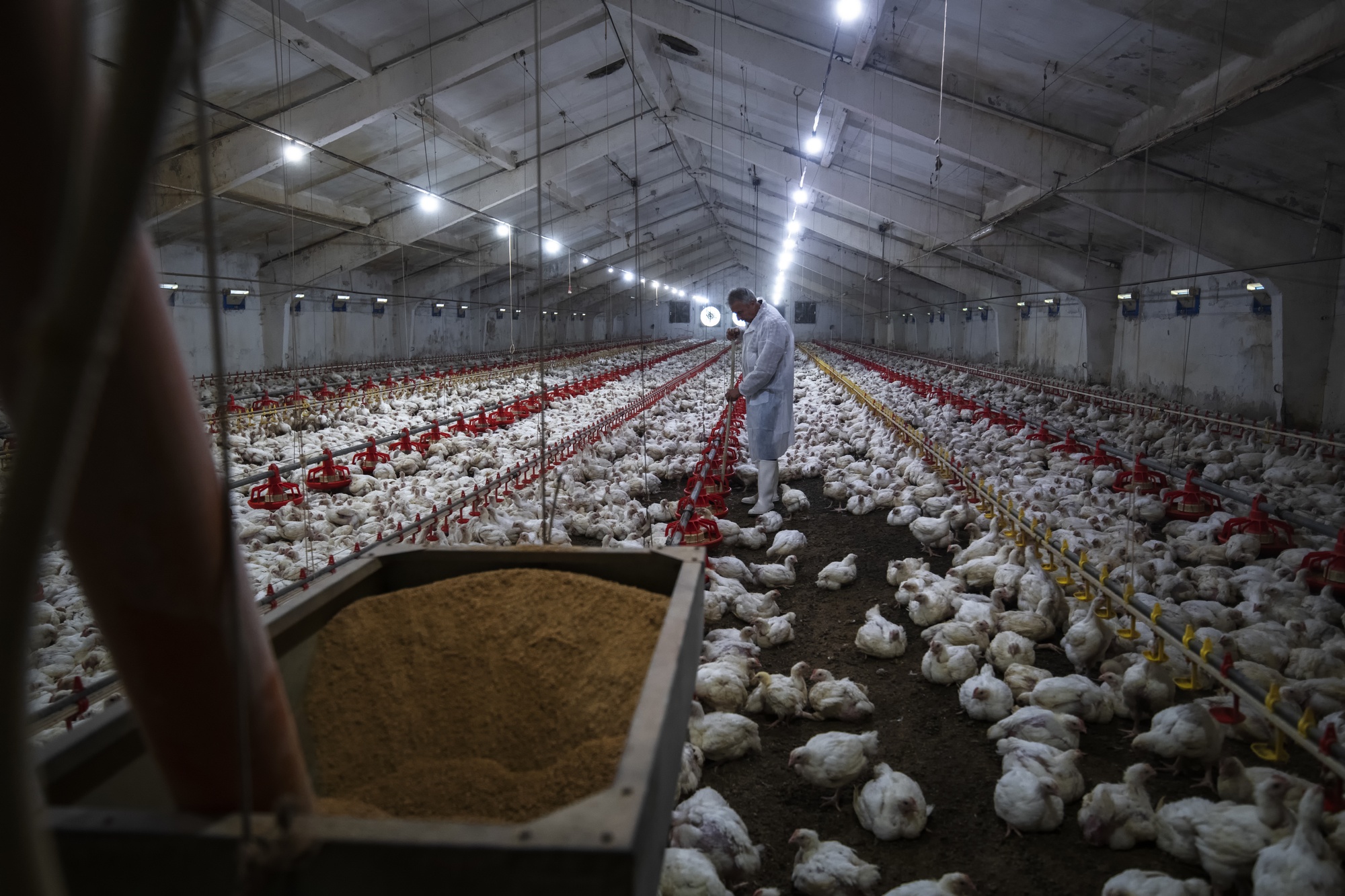
Victims of Salmonella Infantis Pattern 1080 reported eating Perdue Farms chicken more than any other brand, when USDA inspectors found the strain in raw chicken, more than a quarter of the samples came from Purdue plants. Yet, USDA inspectors allowed chicken production to continue as their policies allow salmonella in poultry destined for human consumption.
The country’s antiquated meat safety system virtually ensured it would be no match for a germ like infantis.
The USDA operates under a law passed in 1906, where inspectors physically examine every carcass for signs of animal disease, illegal additives and spoilage. The system didn’t account for invisible pathogens like salmonella and E. coli, which had not yet been linked to eating meat.
That did not change until 1994 after four children died from eating Jack in the Box hamburgers. The USDA made it illegal to sell meat tainted with a strain of E. coli called O157:H7. But it didn’t ban salmonella despite a series of high-profile outbreaks in chicken. Instead, the USDA required processing plants to limit how often salmonella was found on their products and began testing for it. Plants that repeatedly violated these standards faced a shutdown.
The country’s antiquated meat safety system virtually ensured it would be no match for a germ like infantis.
That powerful threat didn’t last long. In 1999, a Texas meat processor challenged the USDA’s authority to close plants, arguing that salmonella “appears naturally” in raw meat. Two years later, the 5th U.S. Circuit Court of Appeals agreed that Congress hadn’t given the agency the power to regulate salmonella that’s present before products enter processing plants or to deem a facility unsanitary based on the bacteria alone.
The decision, Supreme Beef Processors v. USDA, has left the agency gun-shy, according to former department officials and food safety advocates. And Mansour Samadpour, a microbiologist who runs a testing and consulting firm that works with the food industry, said the decision distorts the underlying science. Just because salmonella “colonizes” chickens’ guts doesn’t mean it’s “the natural state of the animal,” he said. “It’s nonsense.”
The court ruling severely clipped the USDA’s powers. So it has tried to pressure plants to improve by creating standards for how often salmonella should be found. Plants are rated on the results, which are published online. Violating those standards doesn’t carry a penalty, but it allows the agency to visit the plant and look for more general problems like unsanitary conditions. If they can document significant problems, the USDA can temporarily shut down the plant, though the agency rarely takes such action.
Today, food poisoning sickens roughly 1 in 6 Americans every year, according to the CDC, and salmonella hospitalizes and kills more people than any other foodborne pathogen. Each year, about 1.35 million people get sick from salmonella. While most recover, more than 400 people die and 26,500 people are hospitalized. Some are left with long-term conditions like severe arthritis and irritable bowel syndrome. Salmonella costs the economy an estimated $4.1 billion a year, more than any other type of food poisoning.
Salmonella outbreaks have been linked to other foods like onions, but poultry remains the biggest culprit, and people are eating more of it than ever. On average, people in the U.S. eat nearly 100 pounds of chicken each year, a number that has grown by about 40% in the last 25 years.
Each year, about 1.35 million people get sick from salmonella. While most recover, more than 400 people die and 26,500 people are hospitalized.
Cooking poultry to an internal temperature of 165 degrees will kill salmonella. But studies by the USDA and others have found that despite decades of consumer education, home cooks routinely cross-contaminate their kitchens, and few use a meat thermometer to ensure their poultry is cooked properly.
Illnesses haven’t declined even as salmonella rates in raw poultry have. And infections are getting harder to treat. The CDC recently found that salmonella infections were becoming increasingly resistant to antibiotics. In contrast, food poisoning related to E. coli O157:H7 has dropped by about 70%.
Consumer advocates, industry consultants and former USDA officials say that’s because the agency focuses solely on whether salmonella is found in chicken or turkey at the processing plant.
This approach has been criticized for years. One former meatpacking executive called it “worthless.” Even the USDA’s own research arm has said the agency’s measure for salmonella is “not a good indicator” of food safety.
The USDA doesn’t consider two key risk factors: how much salmonella is in the poultry and how dangerous that type of salmonella is. There are 2,500 types of salmonella, but only a fraction cause the vast majority of illnesses.
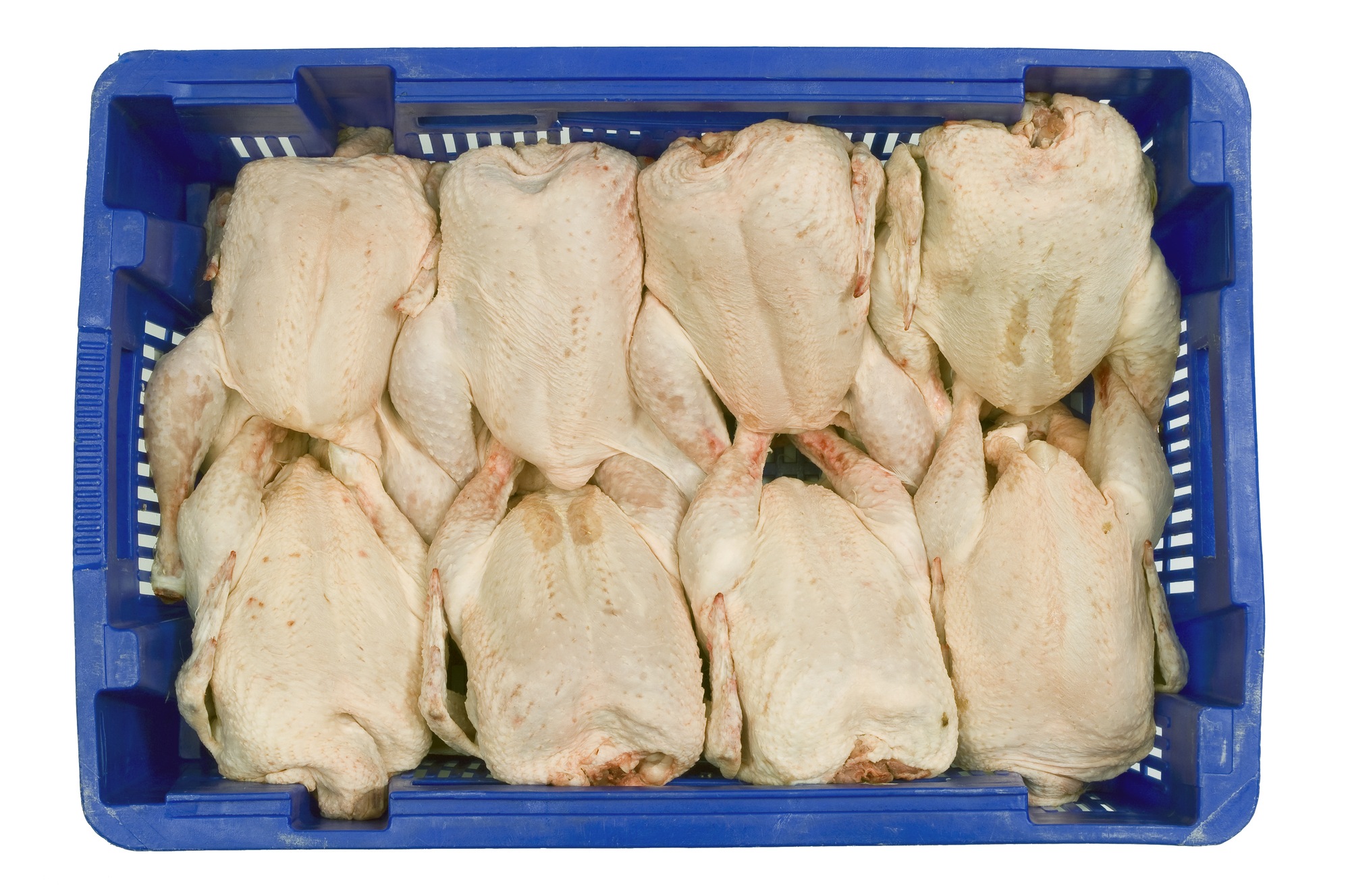
The USDA’s salmonella testing efforts have fallen short, on an average day in 2020, the organization took about only 80 samples of raw poultry across hundreds of processing plants which slaughter more than 25 million chickens and turkeys a day. Criticism has come from within, the USDA’s own research arm has said the agency’s measure for salmonella is “not a good indicator” of food safety.
The industry has greatly reduced the prevalence of one common type of the bacteria, known as salmonella Kentucky, which rarely causes illnesses in the U.S. But it’s made far less progress with the types of salmonella most likely to make people sick, the ProPublica analysis found.
The rate of infantis, for example, has more than quintupled over the past six years.
The full extent of the salmonella problem isn’t even known. The agency does little testing for salmonella to begin with. On an average day in 2020, the USDA took about 80 samples of raw poultry across hundreds of processing plants. But those plants slaughter more than 25 million chickens and turkeys a day.
In recent years, consumer advocates have recommended the agency ban the sale of raw meat carrying the types of salmonella that most often make people sick. That approach has contributed to improvements in Europe. In the U.S., the FDA has seen a dramatic decrease in salmonella outbreaks tied to eggs since the 1990s when it began targeting the most common type.
The full extent of the salmonella problem isn’t even known.
Last month, a few of the largest poultry companies, including Perdue and Tyson, joined with the CSPI and other consumer advocates to urge the USDA to fix the system. But the letter to the agency didn’t outline specific reforms, and a consensus on salmonella regulations has long proved elusive.
The last push came during the Obama administration, but citing the need for more data, the USDA rejected a proposal to ban certain antibiotic-resistant strains. The agriculture secretary at the time was Tom Vilsack, who now leads the agency again under President Joe Biden.
As the food safety project director for the Pew Charitable Trusts before joining the USDA, Eskin also pushed for reform, but her efforts were met with resistance. With food safety directors from some of the largest companies, she helped craft recommendations to Congress to modernize the meat safety system, including setting new limits on salmonella contamination and giving regulators oversight of farms.
The group sought to enlist trade associations, which represent not only the biggest players but hundreds of other companies. But when it comes to regulation, divergent interests often leave the trade groups lobbying for the lowest common denominator. “They shut us down,” she said in an interview before taking her government post. “They’re the ones that blocked us — not the companies, the trade associations.”
Asked what was standing in the way of change, she said, “I’ll make it simple: Powerful interests in the industry do not want it.”
“We are basically only talking about protecting industry”
Just months before the infantis outbreak started, the USDA gathered representatives from the food industry, researchers and regulators at the agency’s brick-and-limestone headquarters in Washington to discuss a scientific breakthrough that one participant called the “biggest thing” for food safety in 100 years.
Whole-genome sequencing had given food safety researchers an unprecedented look at the DNA of foodborne bacteria. New technology, known as “next-generation sequencing,” was creating a trove of new information and revealing connections that could help investigators stop outbreaks before they spun out of control.
As stakeholders took turns presenting slides in the wood-paneled auditorium, some spoke of the possibility that genome sequencing might help solve the stagnant rate of salmonella poisoning.
The new technology would help identify pathogens in foods like raw flour, peaches and romaine lettuce that were once rarely seen as sources of outbreaks.
While whole-genome sequencing couldn’t confirm the source of an outbreak without additional evidence, it provided powerful clues about the bacteria’s genetic history that could point epidemiologists in the right direction.
But for all the potential, much of the conversation that day in October 2017 centered on how to make this scientific breakthrough palatable to industry. Trade groups had requested the meeting, and they voiced concerns about how the new tool could be used for enforcement or might inaccurately connect companies’ products to outbreaks. Speakers, including USDA officials, emphasized the importance of proceeding with caution. They discussed strengthening firewalls to keep testing data private and establishing “safe harbors” from USDA enforcement.
“We are basically only talking about protecting industry here. I thought that this was, the basic purpose was to protect consumers, avoid American consumers and other consumers from dying from eating food.”
During a roundtable discussion, one representative from the United Fresh Produce Association raised concerns about the idea of companies sharing genome sequencing data with the government. “I think right now, it’s viewed as very one-sided,” she said. “We see the benefit to the agencies, but it’s less clear how a company would directly benefit.”
The industry’s influence wasn’t lost on regulators. Former USDA officials hold key posts at some of the food industry’s biggest companies. Indeed, two people who led the 2017 meeting for the agency now work for the food industry.
Sitting in the auditorium, Jørgen Schlundt, the former head of food safety for the World Health Organization, was growing increasingly frustrated. Schlundt had helped achieve dramatic reductions in salmonella in Denmark while working for the country’s food agency.
“I understand that I’m in the U.S., but surely this must also be about protecting consumers,” he told the audience. “We are basically only talking about protecting industry here. I thought that this was, the basic purpose was to protect consumers, avoid American consumers and other consumers from dying from eating food.”
While the USDA tiptoed around the new technology, whole-genome sequencing, which is now used to solve criminal cases and track COVID-19 variants, would prove pivotal to the CDC’s infantis investigation.
The antibiotics that your doctor is going to pick when they suspect you have a salmonella infection are pretty likely not to be effective.”
As the infantis outbreak spread, epidemiologists noticed something unusual: The outbreak strain, Pattern 1080, carried an unusual combination of antibiotic-resistance genes that looked similar to another strain they’d seen before, Louise Francois Watkins, an epidemiologist at the CDC, said in an interview.
At the time, the CDC was still using a method called pulsed-field gel electrophoresis, or PFGE, which produced barcode-like patterns from the bacteria’s DNA that scientists used to connect cases. So the investigators asked the lab to line up the patterns and compare the two strains.
“And sure enough,” Francois Watkins said, the strains were so similar, they differed by “only a single band” of the barcode. With that clue, they decided to analyze the strains using whole-genome sequencing.
That allowed scientists to compare the individual building blocks in the genomes of bacteria. And the infantis investigators discovered that not only were the two strains genetically similar but that PFGE was masking the scope of the problem.
In fact, Pattern 1080 was just one wave in a much larger surge of drug-resistant infantis — one that had been detected nearly a decade ago in Israel and was now circulating worldwide in countries as far apart as Italy, Peru and Vietnam.
“We don’t want to see resistance climbing in our food supply because it’s not going to stay in that one space.”
One of the reasons the U.S. variant is so concerning is that it typically carries a unique gene that makes it especially hard to treat.
“It’s resistant to four of the five antibiotics that are commonly recommended for treatment,” Francois Watkins said. “The antibiotics that your doctor is going to pick when they suspect you have a salmonella infection are pretty likely not to be effective.”
The strain is also a major public health concern because it has the ability to pass those genes to other bacteria, adding to the growing global problem of antibiotic resistance.
“We don’t want to see resistance climbing in our food supply because it’s not going to stay in that one space,” Francois Watkins said.
Whole-genome sequencing had helped investigators discover that the outbreak was actually a widespread problem in the country’s chicken supply.
But even with these new revelations, public health officials still lacked one of the most basic tools to control the strain.
“A gap in our regulations”
CDC investigators knew that infantis was spreading in chickens long before the birds arrived at the slaughterhouse. But enlisting the USDA’s Food Safety and Inspection Service would be a dead end because the agency has no regulatory authority over farms. The USDA can only force farms to take measures when animals get sick, not when humans do.
That also made it difficult for the CDC investigators to pursue leads involving breeders and feed suppliers to trace back how dangerous bacteria got into the food supply.
“That’s a gap in our regulations,” Tauxe of the CDC said.
Nearly all the chickens we eat descend from birds bred by two companies, Aviagen and Cobb-Vantress, a subsidiary of Tyson Foods. This breeding process has allowed consumers to walk into any grocery store and find chicken of the same quality. But that pyramid structure also makes it possible for salmonella to circulate since the bacteria can be transferred from hens to their offspring, and a single breeding flock might produce 3 million chickens over several years. (Both companies declined to comment.)
And nearly every step of their journey from chicken house to our plates presents an opportunity for salmonella to spread.
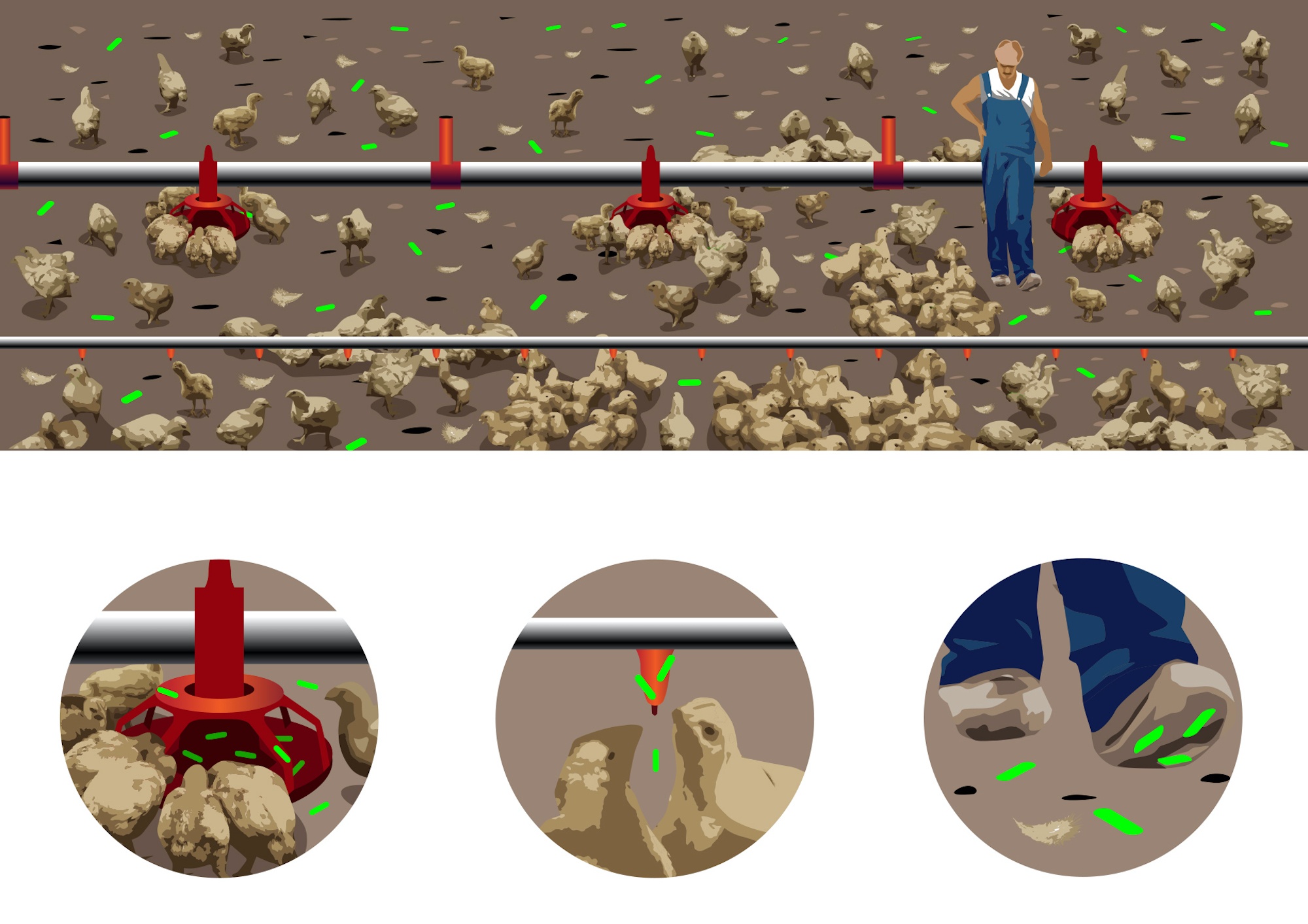
When chickens are raised in crowded conditions, bacteria can proliferate through close contact. Contaminated feed, communal water, and pests or farmworkers’ boots as they move between flocks can all be sites for bacteria.
Daniel Hertzberg for ProPublica
As far back as 2005, the USDA has held public meetings exhorting the poultry industry to take steps at the farm. It has recommended that farmers change or chemically treat the litter between flocks, use traps and bait to eliminate pests and vaccinate hens and chicks against salmonella.
Denmark, Sweden and Norway have largely eradicated salmonella on farms by keeping chicken houses clean, frequently testing the birds and destroying infected breeding flocks.The United Kingdom has dramatically reduced salmonella illnesses by pressuring the industry to vaccinate.
The structure of the U.S. chicken industry makes it ideally suited to implement such interventions. The same company that slaughters the chickens often owns the hatchery and feed mill, and it contracts with farmers to raise the chickens to its specifications. The catch is that because companies are essentially doing business with themselves, there’s little incentive for any of them to press others to reduce salmonella, the industry consultant Samadpour said.

Salmonella can also develop in poultry litter, the organic material like sawdust that’s spread on chicken house floors. As time passes, it becomes increasingly soaked in excrement, serving as a “reservoir of salmonella contamination,” according to the USDA.
Daniel Hertzberg for ProPublica

In some countries, such as Sweden and Mexico, the bedding is typically changed after every flock, or about every five to seven weeks.
Daniel Hertzberg for ProPublica
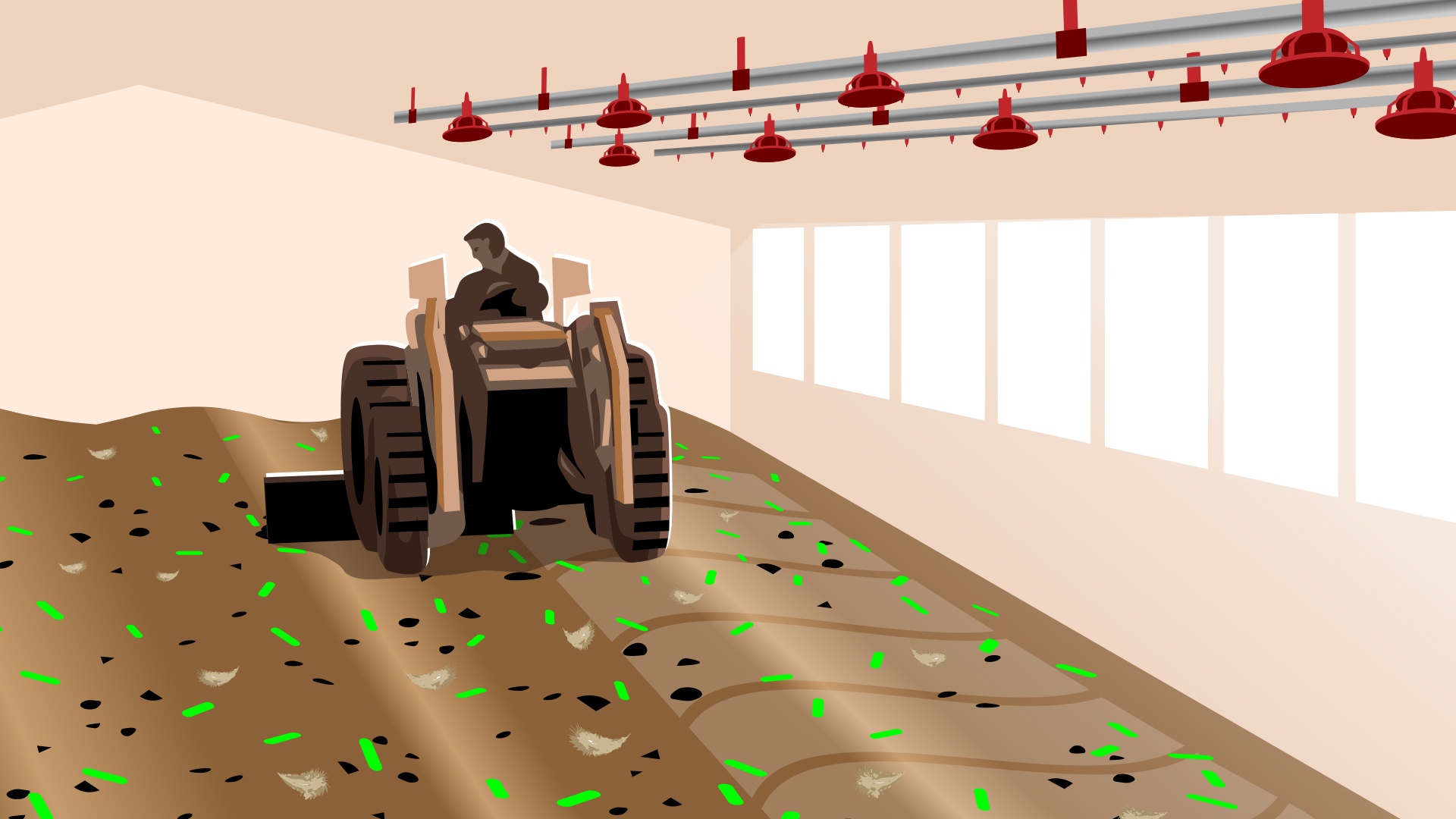
But in the U.S., the litter is treated and turned over but often changed only once a year, according to the Agriculture Department.
Daniel Hertzberg for ProPublica
“If it was four or five different companies,” he said, “the processing plant would tell the farms, ‘If you are more than so much positive, you can’t send it here,’ the farm would tell the hatchery, ‘If the chicks coming in are positive, we are not going to take them.’ They would tell the feed mill that if the feed is contaminated with salmonella, ‘We are not going to bring it in.’ Can you do that? No, it all belongs to you.”
Because more isn’t done on the farm, the birds’ skin and feathers are often highly contaminated with salmonella by the time they reach the processing plant, according to the USDA. And in the plant, there are many ways bacteria can spread.
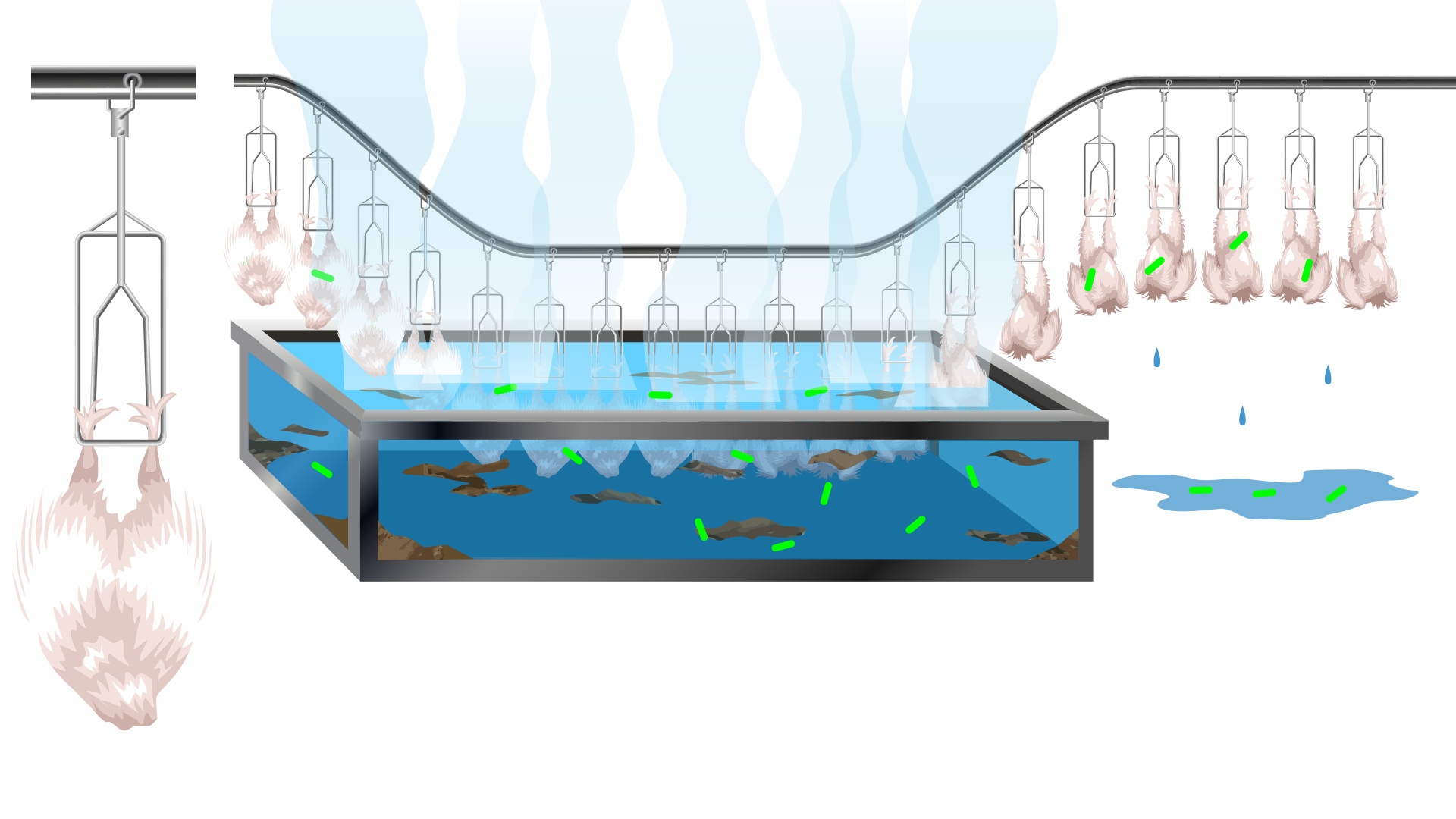
To loosen their feathers, chicken carcasses are dunked into a tank of scalding water. This step can remove dirt and feces. But if the water isn’t managed properly, it becomes fetid, spreading bacteria among the birds.
Daniel Hertzberg for ProPublica
Birds can be further cross-contaminated when workers cut carcasses into breasts, legs and wings. The USDA recommends workers wash their hands and sanitize knives between each bird. But workers often have a few seconds to make each cut.
Ground chicken, which has become increasingly popular, is especially prone to contamination. Meat sent to the grinder comes from multiple birds, increasing the chance of cross-contamination. The fine texture of ground chicken can also get caught in small pieces of equipment, potentially tainting multiple batches.
While salmonella is found in 8% of the chicken parts tested by the USDA, 25% of ground chicken samples contain the bacteria.
And when the USDA tested for salmonella during the infantis outbreak, more than half of the positive samples were found in ground chicken.
“The company can do whatever it wants”
In July 2018, as outbreak investigators began to discover infantis in Perdue products, the USDA had a chance to press the company for answers. Routine salmonella testing had found that the company’s plant in Cromwell, Kentucky, was exceeding the USDA’s salmonella standards, which say no more than 15.4% of chicken parts at a plant should test positive for the pathogen.
So USDA staff were sent to conduct an assessment of the plant, which might have seemed well-timed. Of the 76 plants where the infantis outbreak strain had been found, Cromwell, with 8% of the positive samples, had more than any other facility. But failing the agency’s salmonella standard doesn’t give the USDA the power to do anything more than review the plant’s practices.
The USDA noted that Perdue had responded to its high rate of salmonella by adding more chemical dip tanks and sprays to disinfect the chicken. Because Perdue’s internal sampling data showed the new steps appeared to be reducing the bacteria, the agency gave Perdue more time and recommended “no further action be taken.”
According to the USDA report, Fluckey, then the food safety director at Perdue, told auditors that the agency’s testing didn’t paint an accurate picture of the plant because it wasn’t measuring the quantity of salmonella. He added that Perdue managers hadn’t concentrated on the salmonella types most likely to make people sick because they were focused on “meeting the performance standard.”
A year later, USDA sampling indicated that the plant had continued to violate salmonella standards, with a third of chicken parts testing positive for the bacteria. In addition, the USDA said 12 of Perdue’s samples were highly related genetically to samples from people who’d recently gotten sick.
ProPublica found that many plants have repeatedly violated the agency’s standards without being shut down or facing any recent public sanction.
Still, the agency once again deferred to the company’s testing results, which showed a decrease in the rate of salmonella at the plant. The USDA decided it couldn’t cite the plant and that no action was necessary.
ProPublica found that many plants have repeatedly violated the agency’s standards without being shut down or facing any recent public sanction. According to the most recent data, more than a third of the plants producing ground chicken are violating the USDA standard. And many large companies — including Tyson, Pilgrim’s Pride, Perdue, Koch Foods and the processors that produce chicken for Costco and Whole Foods — currently have plants with high rates of the types of salmonella most likely to make people sick.
Whole Foods said it has a team of experts who review the salmonella results of its suppliers and works with them to lower their salmonella rates. The processor, Pine Manor Farms, said it has “worked diligently to make corrections.” Tyson and Costco declined to comment; Pilgrim’s and Koch didn’t respond to questions.
Other Perdue plants where the infantis outbreak strain was found also had a poor track record with salmonella overall. In the last three years, its plants in Rockingham, North Carolina, and Georgetown, Delaware, had more than 35% of their ground chicken samples test positive for the bacteria, and nearly all of them were types commonly linked to human illnesses. Yet neither plant has faced any recent public enforcement action, according to a review of USDA reports. (In April, ProPublica requested detailed files for both plants, but the USDA has yet to provide them.)
“I can’t control something that’s coming in from somewhere else unless I stop using it.”
In an interview before she joined the USDA, Eskin said the consequences for companies violating the standards aren’t “anything meaningful in terms of enforcement.” “At the end of the day,” she said, “I think the company can do whatever it wants.”
The USDA doesn’t appear to have traced the supply chain for the plants that tested positive for the outbreak strain. Detroit Sausage had one of the highest numbers of samples with the strain.
Phil Peters, one of the owners, said he doesn’t remember anyone from the USDA asking the company who supplied its chicken. “I can’t control something that’s coming in from somewhere else unless I stop using it,” he said.
The company no longer produces chicken sausage because his clients no longer order it. But as a small processor, Peters said, he has little ability to demand chicken companies provide him meat carrying less salmonella. “They’re too big to worry about us,” he said.
A hidden “epidemic”
With no powers of its own and stuck with a hesitant regulator in the USDA, the CDC’s investigators needed the industry’s help.
On Aug. 8, 2018, the CDC offered a stark assessment of the outbreak to representatives of the industry’s trade group, the National Chicken Council: Drug-resistant infantis had become a “particular clinical and public health concern” because it was spreading through the chicken industry and increasingly making people sick.
The USDA seemed to take a less urgent approach. After an Aug. 16 foodborne illness investigations meeting with infantis on the agenda, an agency official wrote that there were “zero active illness investigations.” The USDA had begun tracing victims’ grocery purchases, but beyond that, it decided infantis was an “illness cluster” to watch — not a situation that required additional resources.
By then, three months into the outbreak investigation, neither the CDC nor the USDA had said anything to consumers.
People continued to get sick. Twelve days after the USDA meeting, a New York City resident began having stomach cramps. The patient’s spouse told investigators the victim had eaten and shopped in the Flatbush section of Brooklyn. The patient went to the hospital but died two days later, the first known fatality from the infantis outbreak.
The USDA had begun tracing victims’ grocery purchases, but beyond that, it decided infantis was an “illness cluster” to watch — not a situation that required additional resources.
For nearly two months, there was still no public warning.
In October 2018, the CDC privately met again with the National Chicken Council. By then, public health officials were convinced that the outbreak strain originated high up in the chicken supply chain.
“The outbreak strain may be persisting in chicken populations, their environments or their feed,” according to the CDC’s presentation to the industry group. “Further investigation is needed to help prevent new illnesses and similar outbreaks in the future.”
The CDC drew up a list of questions for the National Chicken Council:
How was it possible that so many different companies could have the same strain of salmonella infantis? Were common sources of chickens, eggs or other farming products widely used? Would one or more companies be willing to partner with the CDC and USDA to explore possible connections?
The council didn’t have many answers. According to a government official’s notes, the industry said that it “does a lot to try to reduce salmonella across the board,” but that it didn’t have a specific preventative measure for infantis. An industry representative added that it “might have been helpful to have the discussion 4 years ago,” when the first signs of drug-resistant infantis popped up in processing plants.
A few days after the October meeting, a 2-year-old Michigan girl began rubbing her belly before developing a fever and diarrhea, making her the latest Pattern 1080 patient. Her parents said that before she got sick, she’d eaten chicken nuggets and touched a package of raw chicken in their kitchen.
The CDC emphasized how risky this particular bacteria was because of its resistance to first-line drugs used to treat salmonella, especially illnesses involving children and patients with blood infections.
The next day — more than nine months after the first patient from the outbreak got sick — the CDC issued its first public notice. By then, 92 people in 29 states had been infected with the outbreak strain. But the number was likely far higher: The CDC estimates that for every confirmed salmonella case, an additional 30 are never reported. That meant that nearly 3,000 people had likely been infected.
Though the CDC knew that infantis wasn’t a typical outbreak strain, the notice offered little advice to consumers other than to remind them to follow standard food safety steps when handling raw poultry. The CDC told ProPublica that there was little more it could say to consumers. Infantis was so pervasive, Tauxe said, that the CDC couldn’t tell consumers to avoid any specific kind of chicken or brand.
Instead, public health officials held another private meeting with the chicken industry in February 2019, telling trade organization officials that they considered this strain of infantis to be an “epidemic.”
The CDC emphasized how risky this particular bacteria was because of its resistance to first-line drugs used to treat salmonella, especially illnesses involving children and patients with blood infections.
Health officials also presented the clues that had pointed toward Perdue as a potential source of some of the illnesses. The agency wanted to sit down with Perdue, but with no power to compel the company to answer questions, it would be months before a meeting happened.
A little over a week after the February 2019 meeting with industry, the CDC closed its investigation. In its second and last public notice about the outbreak, it said 129 people had gotten sick, 25 had been hospitalized and one person had died. There was no mention of Perdue or any other company.
In ending the investigation, the CDC seemed to send mixed messages. While the agency noted that “illnesses could continue because this salmonella strain appears to be widespread in the chicken industry,” it also told Consumer Reports that the decision was prompted by a decrease in new cases.
Infantis strikes another victim
Five months after the CDC closed the infantis investigation, Arthur Sutton and Marva Lamping walked into El Rodeo, a lively Mexican restaurant in Bend, Oregon, where copper art hangs on rustic yellow walls and red-clay mosaics line the archways.
The couple typically went there at least once a month after paying their mortgage or when friends were in town. Sutton’s stomach had been bothering him since eating there the week before, but he didn’t know why. He decided he was up for going out anyway. It was his 70th birthday, and the couple always went to El Rodeo for their birthdays.

Arthur Sutton, a resident of Bend, Oregon, fell sick from chicken consumption at one his favorite neighborhood restaurants. His contraction of a fatal illness could have been prevented by imposing known European regulations, the CDC had closed its infantis investigation 5 months earlier.
Lamping and Sutton had met 15 years earlier at the local community college when Sutton decided to put his past struggles with addiction to constructive use by becoming a counselor. After math class, a group of students would go out to a Mexican restaurant.
“He just one day said, ‘I noticed when we go out for nachos, that you don’t have a margarita with all the other ladies,’” Lamping said. “And I said, ‘No, I don’t drink and drive.’ And he said: ‘Well, I’ll give you a ride. If you’d like a margarita, I’ll take you.’”
Lamping, 63, was drawn to Sutton’s warm and accepting way of engaging with the world — a demeanor that seemed perfectly suited for his counseling work. Lamping said his clients clearly had a bond with him. Once, while he and Lamping were stuck in construction traffic, a former client working as a flagger recognized Sutton and came over to shake his hand.
Sutton, a large man with a square chin, broad forehead and glasses, was quieter than usual that night as a waiter brought out tortilla chips, salsa and a small oval dish of chopped cabbage slaw mixed with diced jalapenos, tomatoes and cilantro. Lamping went to play a few rounds of video slots in the back of the restaurant before dinner while Sutton dug into the salsa and slaw.
Those appetizers would take on grave importance for Lamping after Sutton developed severe food poisoning that night. She said that during its investigation of Sutton’s illness, the county Health Department would ask her if Sutton had eaten salsa and slaw, which an investigator later described in an internal email as the “likely culprit” behind multiple food poisoning cases connected to the restaurant.
El Rodeo’s owner, Rodolfo Arias, said he “didn’t know anything” about the investigation.
An inspection of the restaurant would find concerns with cross-contamination because El Rodeo thawed and washed frozen chicken in the same three-compartment sink in which it washed lettuce, tomatoes and cilantro. Inspectors also noted the faucet was “uncleanable” because it was wrapped in black tape.
Arias denied that his restaurant was responsible for Sutton’s illness. “I don’t think it was possible,” Arias said.
After dinner, the ache in Sutton’s stomach erupted. He began vomiting and couldn’t lay down to sleep. By the next morning, he could no longer stand the pain. He called Lamping at work, where she handles patient admissions at St. Charles Medical Center. She went home and took him to the emergency room, several hundred feet from her desk.
After a CT scan, a doctor diagnosed Sutton, who was obese and had other medical problems, with a hernia. He was discharged with plans for surgery.
But the pain didn’t go away. Ongoing diarrhea sent him to the toilet every 10 minutes. He tried to hide his pain, but Lamping finally convinced him to return to the hospital. “I’m looking into your eyes right now, Arthur,” she remembers telling him. “You’re dying.”

After the first surgery, Sutton’s doctors quickly identified salmonella as the source of his illness and immediately started antibiotics. But after nearly a week, they couldn’t understand why there was no improvement. What Sutton’s doctors didn’t yet know was that a pernicious type of bacteria was poisoning Sutton’s blood: the strain of multidrug-resistant infantis circulating throughout the chicken industry.
Sutton’s hospital stay, detailed in 2,000 pages of medical records provided by Lamping, would be marked by one wrenching episode after another. In the emergency room, when a nurse put a feeding tube up his nose, blood started gushing out.
Still, Sutton maintained his signature equanimity. Medical staff described him in notes as “very relaxed and accepting and taking it all in stride.”
Initially, the intensive care doctors thought Sutton was still struggling with the effects of a complex hernia. But in the operating room, it became clear that things were worse than doctors imagined. His bowels were severely damaged. Surgeons set about removing dead segments of his intestines and reconnecting the functioning parts. They also noted that Sutton had an acute kidney injury caused by “profound” dehydration and septic shock from a widespread infection.
Over 16 days, Sutton underwent a similar procedure seven more times. Surgeons cut out pieces of dead intestine, centimeter by centimeter, and tried to repair tears and leaks in his bowels. Sutton was going in for surgery so often they placed a medical dressing over his abdomen so they wouldn’t have to cut him open every time.
Throughout, Sutton cycled through periods of decline followed by flashes of normalcy. Sleep-deprived, he began hallucinating that there were monkeys in trees and sailboats emerging from the ceiling. But he was also able to sit in a hallway chair in the sun with Lamping, eat a popsicle and jokingly tell the physical therapist, “You look like Tom Cruise.”
Still, Sutton was deteriorating. One day, Lamping found a note on the bedside table that Sutton had scratched out: “Why is this happening?”
Sutton’s doctors were also puzzled. After the first surgery, they’d quickly identified salmonella as the source of Sutton’s illness and immediately started antibiotics. But after nearly a week, they couldn’t understand why there was no improvement.
What Sutton’s doctors didn’t yet know was that a pernicious type of bacteria was poisoning Sutton’s blood: the strain of multidrug-resistant infantis circulating throughout the chicken industry.
To industry, the mystery of infantis “went away”
A month before Sutton got sick, the CDC’s top foodborne disease experts held another meeting with the National Chicken Council. This time Perdue and four other big chicken processors were at the table.
Internal agency notes drafted before the meeting showed officials bracing for an unreceptive audience. “They have known about our concerns for years,” the notes read. “They know about European practices. As a member-run trade association, their position is often driven by the lowest common denominator. Business margins are ‘razor’ thin; some companies are unable or unwilling to embrace expensive control strategies upstream.”
During the three-hour meeting, the group discussed salmonella prevention and lessons learned from infantis.
But the CDC’s message — that infantis was a serious problem that demanded action — doesn’t seem to have resonated with Ashley Peterson, the industry representative who organized and attended the meeting. In September 2019, Peterson, the National Chicken Council’s senior vice president of scientific and regulatory affairs, told trade magazine Poultry Health Today that infantis wasn’t a problem anymore, according to a video of the interview.
“We don’t really understand where it came from or why it went away,” Peterson said.
Learning of Peterson’s comments, Tauxe of the CDC seemed surprised and puzzled.
“It didn’t go away,” he said. “We have met with the NCC repeatedly and have emphasized with them that it’s an ongoing problem. That’s wishful thinking of some kind.”
National Chicken Council spokesperson Tom Super said Peterson was referring to the CDC investigation ending and only learned later that the CDC was still seeing cases of infantis. He added that the industry has invested tens of millions of dollars a year in food safety and it has never downplayed infantis.
Swifter action might have made the difference for Sutton.
More than two years after Peterson’s comments — as infantis has sickened thousands more people — the trade group still hasn’t answered most of the CDC’s questions about the strain and has shared little with the agency about efforts to curb it, Tauxe said.
“How it got into the chickens in the first place, and why it expanded across the country through the chickens and why it’s persisting remain open questions for us,” he said. “Stopping it is going to depend on what the industry is willing to step up to and do.”
Super denied that the industry hadn’t answered the CDC’s questions but didn’t provide responses when ProPublica posed them again. “The industry never stopped working to address salmonella infantis — an effort that continues today,” he said.
Swifter action might have made the difference for Sutton.
At the hospital in Oregon, Sutton’s prognosis worsened. By mid-August 2019, the doctors had learned that the type of salmonella ravaging Sutton’s body was infantis. The finding might have helped doctors change course, but it was too late. The bacteria had already taken its toll.
Back in his room after a half-dozen surgeries, Sutton signaled to Lamping, waving two hands to show that he was done. “He just kept going: ‘Enough, enough. No more,’” Lamping said.
She looked at Sutton and shook her head, refusing to give up. But there wasn’t much the doctors could do.
During his eighth visit to the operating room, a surgeon noted that the leak in his bowels was probably so deep that it wasn’t accessible to surgeons: “Any further dissection would be significantly risking more bowel injury and making his current problem worse,” the medical records said.
More than two weeks into his hospital stay, Sutton’s salmonella infection had led to kidney failure. Sutton would need round-the-clock dialysis and a feeding tube to survive.
“I watched a man go from happy-go-lucky — someone who should have been with me another 20 years — I lost him.”
Lamping and Sutton’s brother, Jim, gathered in Sutton’s room to decide what to do. They agreed that Sutton wouldn’t want to live constantly hooked up to machines.
They told the hospital to stop treatment and move him to comfort care. “Time for him to go to heaven,” Jim Sutton said. After life support was removed, Lamping sat next to the bed and rested her head on Arthur’s hand.
The next day, on Aug. 16, 2019, Arthur Sutton died. The cause was severe blood poisoning and acute organ dysfunction brought on by salmonella. Lamping was paralyzed by grief. Her visions of the future had always included him.
“I watched a man go from happy-go-lucky — someone who should have been with me another 20 years — I lost him,” Lamping said. “I Iost him.”
Two years later, she still replays Sutton’s battle with salmonella over in her mind, certain that something could have been done differently.
Lamping has focused on potential problems with how their food was handled at El Rodeo and hired a lawyer to file a lawsuit against the restaurant in 2020. She blames the restaurant, in part, because a county health inspection after Sutton died noted that it had told El Rodeo about the “findings from the state health lab on salmonella infantis cases.” In court filings, the restaurant denied the allegations.
But Lamping also says there are things that food safety regulators and the industry could have done long before the chicken arrived at El Rodeo.
“If they know that infantis is in the chicken, if they know it’s there, why are they selling it to us?” Lamping asked.
The USDA, to this day, has never said anything to consumers about the risk of multidrug-resistant infantis.
Because of the pandemic, Lamping and Jim Sutton have had to delay Arthur’s memorial. They hope that someday soon, they’ll be able to gather his friends and family on a hill overlooking a canyon in central Oregon.
They’ll walk through shale rock, wildflowers and junipers, and look over the canyon’s edge where a buck can sometimes be seen running through the sagebrush. They’ll open Sutton’s urn and let the wind carry his ashes away.
—
About the data: How ProPublica analyzed bacterial pathogen presence
Data used
ProPublica obtained bacterial pathogen genomic sequencing data from the National Center for Biotechnology Information’s Pathogen Detection project. The project integrates data from bacterial pathogens sampled from food, the environment and human patients by participating public health agencies in the United States and around the world. The NCBI analyzes data as it is submitted, and the results are monitored by public health agencies, including the CDC as part of foodborne illness outbreak investigations. The data includes metadata about each bacterial isolate submitted by the person or institute who collected the bacterial sample, as well as computational predictions by NCBI.
Through Freedom of Information Act requests, ProPublica obtained epidemiological information about bacterial samples taken as part of the 2018-19 salmonella infantis outbreak investigation and samples obtained during routine testing in establishments regulated by the USDA’s Food Safety and Inspection Service. ProPublica also obtained epidemiological information connected to patients considered part of this outbreak, including the date of sample collection and details about a patient’s illness, recent food consumption and demographics — details crucial to foodborne illness investigations. Data about bacteria found during USDA inspections also included the type of meat or poultry the sample was obtained from, the date of collection and the name and location of the facility. Integrating these details with the NCBI metadata offered a way to group samples together not just by genetic similarity, but also by location and time.
The USDA posts public datasets containing the results of its salmonella sampling at poultry processing plants since 2015, which detail the collection date, type of poultry product sampled and, if salmonella was present, information on type and any antimicrobial resistance. The datasets include both routine sampling, conducted at every plant, and follow-up sampling, conducted at plants where the agency has identified high levels of salmonella. (Samples from USDA inspections that contain salmonella are reflected in both the NCBI data and the agency’s inspection data.)
Analysis decisions
To confirm the persistence of multidrug-resistant infantis in food processing facilities, grocery stores and patients with salmonella infections, ProPublica relied on both metadata submitted to NCBI and genetic features computed by NCBI. ProPublica restricted its analysis to isolates in the NCBI data belonging to what was known as SNP cluster PDS000089910.78, as of Oct. 19, 2021. This cluster contains most isolates involved in the infantis outbreak, and the CDC said it is monitoring most of the isolates in the cluster. ProPublica also filtered for isolates that were reported to be serotype infantis by the submitter or, when user-submitted information was unavailable, were computationally predicted to be infantis by the NCBI data processing pipeline.
ProPublica used data about evolutionary modeling computed by NCBI to establish the degree of genetic similarity between bacterial isolates from the outbreak and isolates collected more recently.
ProPublica’s analysis of salmonella rates in poultry plants is based on methods the USDA uses, using the agency’s routine sampling data to calculate positivity rates — that is, the number of positive tests compared with all salmonella tests taken at the facility — for each type of poultry a plant processed. ProPublica also calculated the high-risk salmonella rate for plants, determining the percentage of samples at the facility that tested positive for one of the 30 salmonella types the CDC has found to be most associated with human illnesses.
The USDA inspection data was also used to compare the number of samples found to contain salmonella infantis and salmonella Kentucky with the total number of routine samples taken each year to determine the rate at which each was occurring in the sampling program across all plants and poultry types.
—
Maryam Jameel contributed reporting, and Andrea Suozzo contributed analysis.





